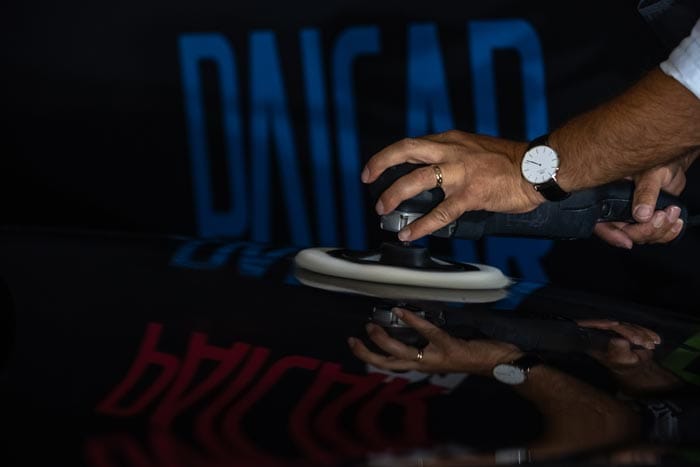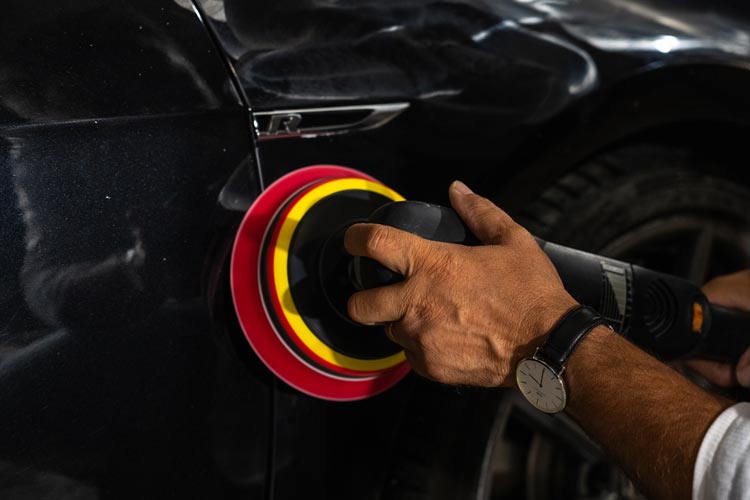Index
Foam or Wool Pad – Which should be used?
INTRODUCTION
In the last articles, we’ve talked about the car polishing, starting from what the polishing is and how to proceed in practical. In addition, we’ve analysed the differences between the rotative and roto orbital polishing machine, discovering that every situation requires the adapt tool.
This article is about a fundamental theme in the polishing world; the pad’ choice. When we are starting for a polishing process, we must keep in mind that the abrasive power is not only due by the polishing compound, but from the entire polishing system. This means that also the pads, the polishing machine and the operator experience are important for a good result. The pad’ choice can be crucial in our process; indeed, it afflict around the 30% on the result of the polishing!
There are two big categories of pads, WOOL PADS and FOAM PADS.

THE WOOL PADS
The wool pads are composed of hundreds of filaments, that hurts the surface. Unlike the foam pads, they have an abrasive capacity themselves; this aspect makes them suitable for the working process on heavily damaged surfaces, because them will be faster in the damage’s removal.
Another important advantage of this pad typology is the air circulation that is permitted by the wool. This prevent the surface from overheating too fast.

There are curved twisted wool pads, and fine lamb wool pads.
The curved twisted wool pads are the most abrasive. They are composed by braided wool threads that hurts the surface, providing a high cut capacity. These pads are too powerfully for the car body care. Their use is predominant in the composite and marine sector, where the surface is gelcoated (the gelcoat is a harder material compared to the car’ transparent layer). Pai Cristal offers two curved twisted wool pads: ST1 (single faced) and ST2 (double faced).
The fine wool pads can also be used in the automotive sector, because their action is less abrasive compared to the curved twisted ones. These pads combine cut and gloss capacities. For example, the SL3 fine wool pad can be used on the car body, because it’s delicate enough to work on the clearcoat, without creating damages.
We can summarize the points of strength and the points of weakness related to the wool pads.
POINTS OF STRENGHT
- High abrasive power, that enables to make the process faster.
- Air circulation, that enables to heat the surface less quickly.
POINTS OF WEAKNESS
- The high abrasive power increases the risk of micro-damages on the surface.
- The curved twisted wool isn’t indicated for the car body, because it’s too abrasive.
THE FOAM PADS
On the contrary of the wools, the foam pads haven’t an own abrasive capacity. They only work as vehicles for the compound’ application on the surface.
They may have different hardnesses. The hardest foams are more aggressive, because them structure allows the operator to make a higher pressure on the surface.
The softer foams are more delicate in the working. They are recommended for the finishing phases, to obtain higher gloss levels.
Also in this context, there are two different categories.
The closed cell foam pads do not allow the air circulation during the working process. This means that the surface will overheat quickly. From one point of view, this is a strength, because an overheated surface is easier to be processed. This makes the process faster.

On the other hand, there’s a higher risk of damages creation due to the overheating, in particular if the working process is performed by a beginner.
The open cell foam pads allow the air circulation through the foam. This means that the surface warming will be slower, and the damages creation risk will decrease. In this context, PaiCar range has a cutting-edge proposal. The D.A. (Dual Action) foam pads line has been recently developed, and it presents a technology that is difficult to find on the market. These pads have a central hole, that is helpful for the operators to adapt the pad on the backplate. In addition to that, there’s an air circulation system that links the central hole with the backplate.
The S15 backplate has 4 air conduits, that are connected to the pad’ hole. This technology consistently helps the working process, increasing the air circulation capacity (open cell & DA technology). The DA system with S15 backplate is adaptable to the rotary polishing machine.
Let’s summaries the strengths and weaknesses of the foam pads:
POINT OF STRENGHT
- They’re able to adapt themselves to the different polishing phases, thanks to the different consistency.
- Using them, it’s possible to achieve the higher gloss levels.
- The DA technology allows an excellent air circulation.
POINTS OF WEAKNESS
- They’re slower in the working process, compared to the wools. This could be a problem in case of deep damaged car bodies.
- The closed cell foams can overheat the surface.
WHICH ONE CHOOSE
Also in this case, the correct answer is that it depends on the surface we’ve to work on, and on our preferences.
When we face the first step on a deep damaged car body, we can choose to use the SL3 fine wool pad, or a hard foam pad (like DA-01 or DA-02). Our choice will then be combined with a high cutting compound, like PAICAR01 or PAICAR02.
For the following steps, when we use a refinishing polish (PAICAR 03 or PAICAR04, depending on our preferences), we will use a soft foam pad, like DA-03 or DA-04).
Remember that paying the necessary attention in the pad’ choice is fundamental to obtain the desired result. The best polishing compound will lose its power, if used in combination with the wrong pad.
What’s your choice?

